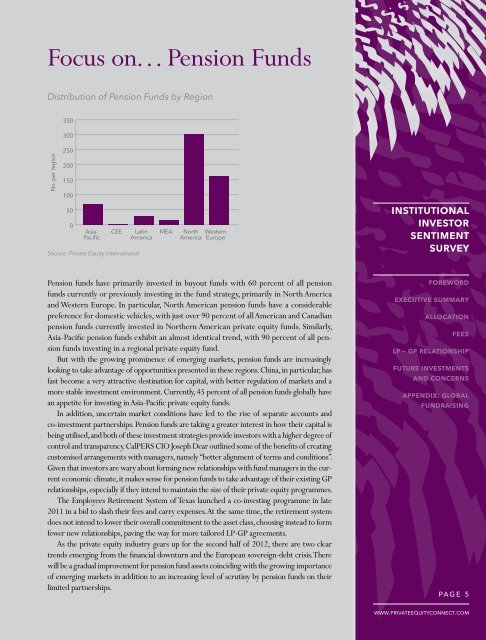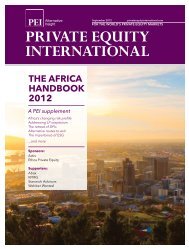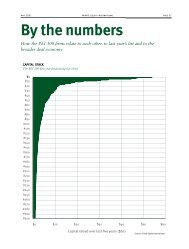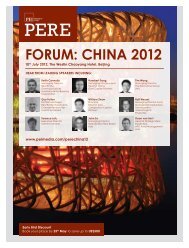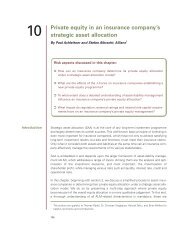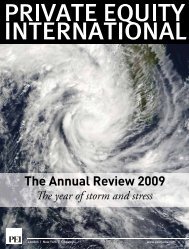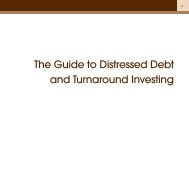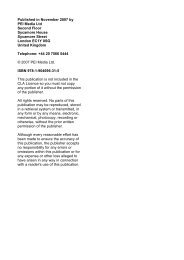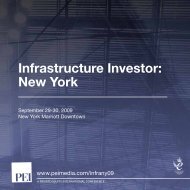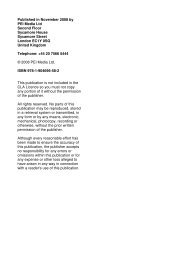INSTITUTIONAL INVESTOR SENTIMENT SURVEy - PEI Media
INSTITUTIONAL INVESTOR SENTIMENT SURVEy - PEI Media
INSTITUTIONAL INVESTOR SENTIMENT SURVEy - PEI Media
Create successful ePaper yourself
Turn your PDF publications into a flip-book with our unique Google optimized e-Paper software.
Focus on… Pension Funds<br />
Distribution of Pension Funds by Region<br />
350<br />
300<br />
250<br />
No. per region<br />
200<br />
150<br />
100<br />
50<br />
0<br />
Asia-<br />
Pacific<br />
CEE<br />
Source: Private Equity International<br />
Latin<br />
America<br />
MEA<br />
North<br />
America Western<br />
Europe<br />
institutional<br />
investor<br />
sentiment<br />
survey<br />
Pension funds have primarily invested in buyout funds with 60 percent of all pension<br />
funds currently or previously investing in the fund strategy, primarily in North America<br />
and Western Europe. In particular, North American pension funds have a considerable<br />
preference for domestic vehicles, with just over 90 percent of all American and Canadian<br />
pension funds currently invested in Northern American private equity funds. Similarly,<br />
Asia-Pacific pension funds exhibit an almost identical trend, with 90 percent of all pension<br />
funds investing in a regional private equity fund.<br />
But with the growing prominence of emerging markets, pension funds are increasingly<br />
looking to take advantage of opportunities presented in these regions. China, in particular, has<br />
fast become a very attractive destination for capital, with better regulation of markets and a<br />
more stable investment environment. Currently, 45 percent of all pension funds globally have<br />
an appetite for investing in Asia-Pacific private equity funds.<br />
In addition, uncertain market conditions have led to the rise of separate accounts and<br />
co-investment partnerships. Pension funds are taking a greater interest in how their capital is<br />
being utilised, and both of these investment strategies provide investors with a higher degree of<br />
control and transparency. CalPERS CIO Joseph Dear outlined some of the benefits of creating<br />
customised arrangements with managers, namely “better alignment of terms and conditions”.<br />
Given that investors are wary about forming new relationships with fund managers in the current<br />
economic climate, it makes sense for pension funds to take advantage of their existing GP<br />
relationships, especially if they intend to maintain the size of their private equity programmes.<br />
The Employees Retirement System of Texas launched a co-investing programme in late<br />
2011 in a bid to slash their fees and carry expenses. At the same time, the retirement system<br />
does not intend to lower their overall commitment to the asset class, choosing instead to form<br />
fewer new relationships, paving the way for more tailored LP-GP agreements.<br />
As the private equity industry gears up for the second half of 2012, there are two clear<br />
trends emerging from the financial downturn and the European sovereign-debt crisis. There<br />
will be a gradual improvement for pension fund assets coinciding with the growing importance<br />
of emerging markets in addition to an increasing level of scrutiny by pension funds on their<br />
limited partnerships.<br />
foreword<br />
executive summary<br />
allocation<br />
fees<br />
lp – gp relationship<br />
future investments<br />
and concerns<br />
appendix: global<br />
fundraising<br />
page 5<br />
www.privateequityconnect.com


